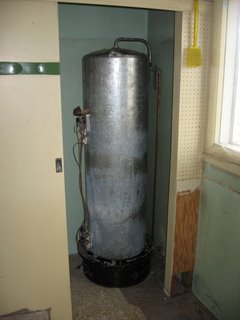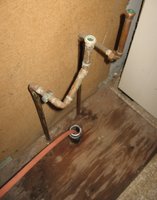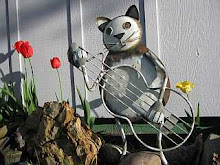Why is it taking so long to drain? Several reasons.
First I didn't get the water heater from Sears until around 11:30 am. Earlier this morning I checked the unmarked 30 and 50 amp circuit breakers. The 50 amp breaker powers the stove and oven. One 30 amp breaker powers the dryer. The final 30 amp breaker didn't affect anything, though I thought - maybe - the slight hum in the water heater disappeared when I turned the breaker off.
It was better to buy the heater today rather than last night as it was raining last night and today was sunny and clear. A wet cardboard box wouldn't be so good.
 Oh yeah, as you may have guessed by now, I bought a 55 gallon Sears Power Miser 12 water heater.
Oh yeah, as you may have guessed by now, I bought a 55 gallon Sears Power Miser 12 water heater.Today there were a few more customers than sales people at Sears. A young woman handled my order as the older guy who helped me last night was busy. Using a cart she even brought the water heater out to my pickup. Together we lifted it into the pickup. She told me to let the heater sit upright 12 hours before using it. Huh? I think she got her large appliances mixed up. A refrigerator with coolant, yes. But a water heater? Nothing inside a water heater I know of that is affected by its laying down.
I stopped at Home Depot to talk with one of their electrician salesman about my wiring and to see if I needed an electrical tester to check for current in the wire. Home Depot is growing on me as their sales people are very helpful. He felt - based on my description - the 30 amp was for the water heater. I didn't buy a tester to double check the wiring.
After stopping by Bob & Jan's house to see how they are doing, and to collect planter pots they no longer wanted, I came home and unloaded the water heater. It was a little tricky to get the heater out of the box without destroying the box as I had unloaded the heater under the roof of my entryway. I was able to tip and hold everything while getting the large box off the top without dropping the heater. It wasn't easy though!
Now to remove the old water heater. First I unhooked the wiring. No shocks so I guess I turned off the correct circuit breaker.
The next step was to drain the water heater. The heater does not have a drain valve. My initial plan was to run a hose from the hot water pipe in the crawl space that goes to the washing machine.
After hooking up the hose, and opening the valve in the crawl space, I discovered the hot water pipe that went to the sink needed to be plugged. I spent forever trying to find some pipe, plug, or hose that would screw into the sink's water pipe. Nothing.
It turns out that time spent looking was wasted as I found unless water goes into the water heater, no water goes out the hot water pipe. The only water I got earlier was the water already in the hot water pipe and outside the water heater.
I then found that the hot and cold water pipes to the water heater had been assembled in such a way that my only option was to cut the pipes. I believe everything was screwed together and then the copper fitting that connects to the galvanized pipe was soldered after being screwed onto the galvanized pipe. For both the hot and cold pipes.
With no drain valve, how does one now remove the pipes without releasing a flood of water?
Let me think.
The cold water pipe enters from the bottom of the tank, and the hot water pipe exits from the top of the tank. I guess I need to cut the hot water pipe first and hope the water pressure isn't such that the water shoots out.
The hot water pipe actually exited the tank at the top, but inside the tin container that surrounded the tank. The pipe crossed the top of the tank, then curved down a foot before exiting the side of the tin container. *sigh* I removed the top part of the container. Of course the pipe exited out of a hole and not a slot. I had to hacksaw the container so I could get the pipe through the bottom part of the tin and up and over the top of the water tank.
Success.
The space between the tin container and the tank was filled with yellow insulation. Hmm... wonder if there is a drain value under all that? I hacksawed through the bottom part of the tin container and pulled it off.
No drain valve. The tank looks great. It looks brand new. Everyone told me to replace the tank because it would be corroded. If it is corroded it is only on the inside. My well tank had signs of rust on the outside so it was no surprise that it corroded through from the inside. It seems to be a waste to toss my water heater tank away, but it is too late to do anything different now.




I hacksawed through the hot water pipe at the top. A little water in the pipe leaked out as I cut but no spray from water under pressure. At least something is going my way.
To get the pipe out of the top of the tank I had to beat it with a hammer to turn it around.
Finally success as I got it off. The next step was to use a hose to siphon the water from the tank. Hours - many hours - later that is where I am. The opening is small so I had to find and use a small hose. Initially the hose I found was short and after filling several 5 gallon pails with water I had to find a longer hose.
The second hose reached to the new open drain pipe for the cabinet sink so that made draining easier. With one end in the drain the other end didn't reach the bottom of the tank, and after supper I had to go back to filling 5 gallon buckets in order to make the hose reach further down into the tank. Even so, I don't think the hose reaches the final few inches of the bottom of the tank. I'll see tomorrow.


I hope I can get most of the water as when I cut the cold water pipe whatever water is left in the tank will come out over the floor.
Also making it difficult to work is the space between the tank and wall is small - especially before I removed the outer tin shell. And the pipes are on the right side of the tank and I am a lefty. That made working harder and slower. I know... excuses, excuses!

While waiting for the tank to drain I prepared my new tank. As I have 10 gauge wire I converted the bottom element of my new tank from 3800 to 5500 watts. Reading the new water heater's instruction booklet I found that 4500 and 5500 watt elements need a 10 gauge wire, while 3800 watts need only a 12 gauge wire. Another confirmation I have 10 gauge wire as my old tank was 4500 watts.
I hope to be done tomorrow and have hot water. I can't wait till I can take a hot shower again.


No comments:
Post a Comment